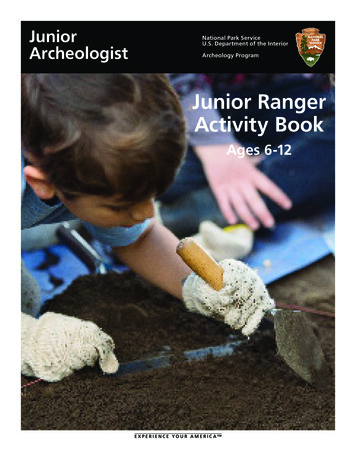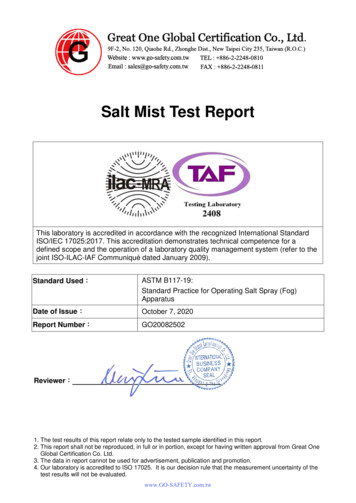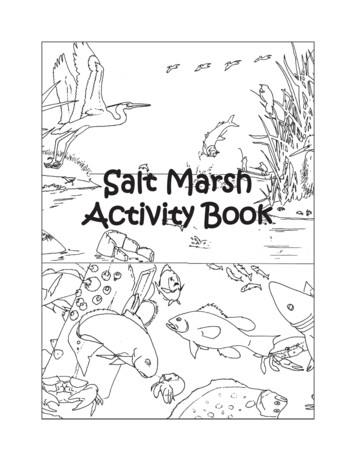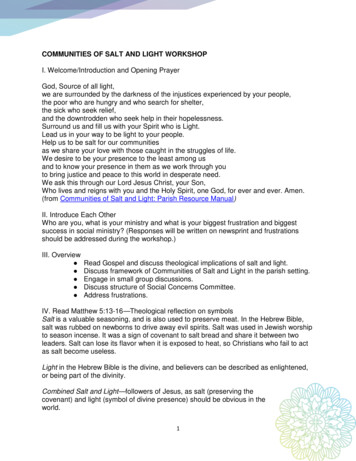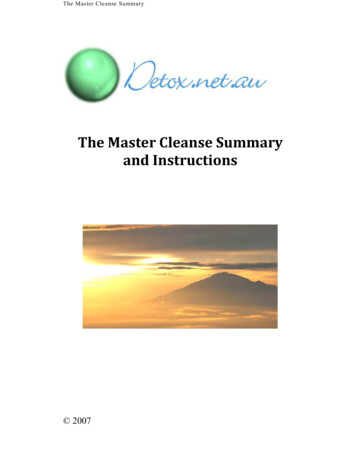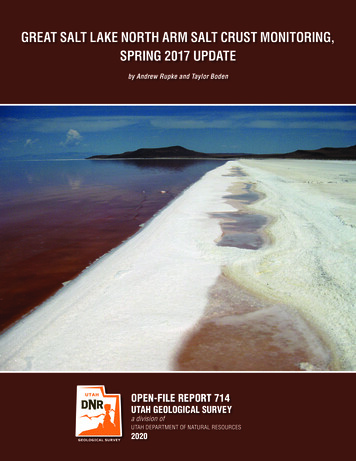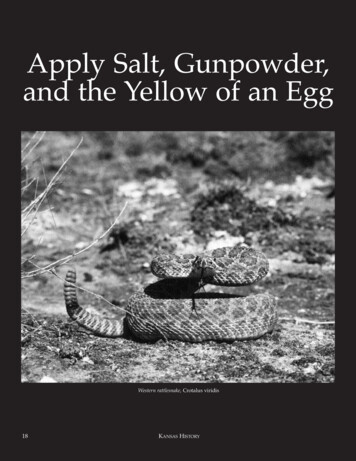
Transcription
Apply Salt, Gunpowder,and the Yellow of an EggWestern rattlesnake, Crotalus viridis18KANSAS HISTORY
The Treatment of Rattlesnake Bitesby the Western Kansas SettlerPby Eugene D. Flehartyioneers met and overcame a variety of environmental obstacles while settling Kansas.Blizzards and extreme cold were common during winter; prairie fires, locust plagues,droughts, violent thunderstorms, and tornadoes were adversities that occurred periodically during the remainder of the year. However, one possible danger was presentdaily from late March through October or early November— the dreaded rattlesnake.Focusing on one decade, the 1870s, from the settlement period, this study examines the habits ofrattlesnakes that brought them into contact with settlers, the attitude of settlers toward those reptiles, the number of bites that occurred during that decade, the number of people who died as a result of those bites, and particularly the efficacy of the different kinds of treatments provided to thevictims.Only two species of poisonous snakes are found in western Kansas. Both are rattlesnakes. Themassasauga, Sistrurus catenatus, occurs in the eastern two-thirds of the state. It occupies a “widerange of habitats ranging from semi-arid sagebrush prairie and rocky, prairie hillsides to open wetlands.” The western rattlesnake, Crotalus viridis, occurs in rocky canyons and open prairies, principally in the western half of Kansas.1 The western rattlesnake, rather than the massasauga, probably caused most of the snake-related difficulties for settlers.Snakes are “cold-blooded” or ectothermic. Therefore, before the subfreezing temperatures ofwinter, snakes must seek refugia from the cold. In autumn, as temperatures decline rattlesnakesEugene D. Fleharty earned a bachelor’s degree from Hastings College, Hastings, Nebraska, and master’s and doctorate degrees from the University of New Mexico. Currently he is a professor of biology at Fort Hays State University. He also is the author of Wild Animals and Settlers onthe Great Plains (1995).For their helpful suggestions with an earlier draft of this manuscript, the author thanks Jerry R. Choate, professor of biological sciences and director and curator of mammals, Sternberg Museum of Natural History, Fort Hays State University, Hays; and Joseph T.Collins, herpetologist emeritus, Natural History Museum, University of Kansas, Lawrence.1. Joseph T. Collins, Amphibians and Reptiles in Kansas (Lawrence: University Press of Kansas, Natural History Series No. 13, 1993),278, 275.APPLY SALT, GUNPOWDER, AND THE YELLOW OF AN EGG19
make their way to “dens” or hibernacula where theyspend the winter sheltered in a semitorpid state. Thetemperatures within the den are low but not freezing.Hibernacula can be almost anywhere snakes canmove below the frost line. In areas with large rocks,hibernacula frequently are in crevices that lead deepbelow the frost line. Duringsettlement of western Kansas,when prairie dogs townswere common, snakes frequently utilized the deep burrows of prairie dogs.2Occasionally these hibernacula would contain largenumbers of snakes, both poisonous and nonpoisonous. Ina hybernaculum near Concordia three thousand snakeswere reported to have beenkilled in October 1876. Fifteenhundred other snakes allegedly were killed at thesame den in May 1878. NearCawker City in September1877 a farmer unearthed 330 snakes while plowing,and in the vicinity of Hays 168 rattlers and 300 othersnakes were killed in a prairie dog town in November 1878. Admittedly these numbers probably suffered from some exaggeration, but it is well documented by herpetologists that dens can harbor largenumbers of snakes.3Kautumn when snakes gathered at dens, or in earlyspring prior to dispersal, large numbers of snakeswould “lay-out” or bask on warm days near the densite. It was at these times, when numerous snakeswere found in a relatively small area and thereforeparticularly vulnerable, that planned snake huntswere undertaken in an attempt to eradicate the “evil”serpents. Hunters near Hutchinson in 1872 killed fifty-fiverattlesnakes in prairie dogtowns in October and November. In the same vicinity, inNovember 1873, more than200 snakes were killed ofwhich 175 were rattlesnakes.The success of these hunts inReno County led the editor ofthe Hutchinson News to predictthat “after next spring a snakewill be a curiosity in the settled portions of Reno County.” A hunt in Barton Countyresulted in fifty-six rattlesnakes killed at a prairie dog town in November1876.5When warm spring days arrive, rattlesnakes leavethe denning areas and move to summer ranges atvarying distances from the den. During the warmerperiods of the year, after these spring dispersals, rattlesnakes seemed to early settlers to be everywhere.They were found in the open prairie, in croplands,gardens, and near outbuildings. They also entereddugouts and sod houses. Because rattlesnakes prefertemperatures between eighty and ninety degrees, settlers had to be particularly vigilant in the early morning and evening hours during spring and autumnand at night during the heat of the summer.6 With onestrike, these snakes could inject enough poison to killansas settlershad, like mostpeople, “an innatefear of snakes.” Tomany settlers, theonly good snakewas a dead snake.Kansas settlers had, like most people, “an innate fear of snakes or, more precisely, . . . aninnate propensity to learn such fear quicklyand easily past the age of five.”4 Therefore, to manysettlers, the only good snake was a dead snake. In the2. Laurence M. Klauber, Rattlesnakes: Their Habits, Life Histories, andInfluences on Mankind, 2 vols. (Berkeley: University of California Press,1956), 541–49.3. Ellis County Star (Hays), October 26, 1876; Pawnee County Herald(Larned), May 14, 1878; Hays City Sentinel, September 21, 1877, November 16, 1878; Klauber, Rattlesnakes, 549 – 52.4. Edward O. Wilson, Biophilia (Cambridge, Mass.: Harvard University Press, 1984), 84; Klauber, Rattlesnakes, 953 – 55.205. Hutchinson News, October 17, 1872; Ellsworth Reporter, November7, 1872; Hutchinson News, November 6, 1873; Inland Tribune (Great Bend),November 4, 1876.6. Klauber, Rattlesnakes, 571 – 75; Collins, Amphibians and Reptiles, 275.KANSAS HISTORY
a child in a matter of hours. Nor were adults immunefrom the poison: according to newspaper reports, theloss of a loved one among Kansas settlers was not unusual, and many grief stricken families were foundon the prairies in the 1870s.During this decade eighty-two separate incidentsof rattlesnake bites were reported. All incidents occurred from March through October. This was notunexpected as ectotherms are not active during lowtemperatures. The majority of the bites (75.6 percent)occurred during June, July, August, and September(Table 1).Most frequently bites occurred as settlersand their families conducted the daily activities required to maintain a homesteador small farm. One factor that influenced the numberof bites was the penchant for farmers and their families to go barefoot. Activities during times when biteswere received included walking or working in thegarden (picking peas, pulling weeds), working theland (plowing, raking hay, picking up fodder, harvesting, binding wheat, picking wild fruit, pulling apicket pin), and recreation (fishing, retrieving a marble from beneath a bed, playing with the snake, chasing a ground squirrel, playing in a cropfield, at-TABLE 1Number and percentage of bites recorded in eachof the warm-weather months, 1870sMonthMarchAprilMayNumber of 67.3JulySeptemberOctober161719.520.7tempting to remove the rattles and skins from “dead”snakes).Treatments were provided to all who were bitten.However, for a variety of reasons many of those bitten probably were in no danger of dying. Most kindsof larger snakes, poisonous or otherwise, will strikein their own defense when threatened. In some of thereported snakebite cases the individual bitten maynot have seen the snake, or if he observed it may havemisidentified it. In addition, even if the snake werepoisonous, the bite might have been “dry,” with either no or insufficient venom injected to cause death.Lack of envenomation can be caused by the snake injecting too little venom; rattlesnakes do not alwaysinject the total amount of venom they have available.Additionally, the venom gland-fang mechanism ofthe snake might malfunction, and in some instancesthe fangs do not hit the victim directly resulting in little injection of venom. It recently was estimated thatabout 25 percent of all poisonous snakebites in theUnited States do not inject enough poison to producesymptoms of venom poisoning. Probably the figure ismuch higher because outpatients were not includedin the study. A recent study placed the percentage ofinsufficient venom injection at about “40 to 50 percent of all poisonous snakebites.”7Rattlesnake venom is neutral or slightly acidic,containing a “mixture of proteolytic enzymes, neurotoxin, bacteria, cell detritus, various proteins, andelectrolytes.” The neurotoxins kill the prey, and theproteolytic enzymes begin digestion proprietary toingestion. The neurotoxin of Kansas snakes is ofminor importance except in cases of massive poisoning. The protelytic enzymes digest the tissue locallyaround the bite, destroy linings of the blood vessels,and inhibiting blood clotting through interactionswith blood proteins. Additionally, the enzyme lecithinase causes destruction of red blood cells.87. Henry M. Parrish, Poisonous Snakebites in the United States (NewYork: Vantage Press, 1980), 328, 330; Henry M. Parrish, J.C.Goldner, andS.L.Silberg, “Poisonous Snakebite Causing No Venenation,” PostgraduateMedicine 39 (March 1966), 267.8. John W. Schmaus, “Envenomation in Kansas,” Journal of the KansasMedical Society 60 (June 1959): 238.APPLY SALT, GUNPOWDER, AND THE YELLOW OF AN EGG21
In an attempt to counteract the effects of rattlesnake venom, a variety of “remedies” was used onthose unfortunate individuals who were bitten on theplains of western Kansas. These remedies fell intofour categories: whiskey, either alone or with one ofthe following; incisions or excisions, usually in combination with sucking the poison from the wound oramputations; some kind of cauterization; and a poultice of some sort, either to neutralize the poison or todraw it out.Over the centuries many “folk” remedies forpoisonous snakebites have been used. Because of the limited knowledge of snakebite, venom, and the circulation of those poisonswithin the body, most folk treatments were ineffectual. In some instances, the “remedy” may have causedthe death of the victim. These remedies, passed fromgeneration to generation, were not based on scientific studies. Rather, they were founded on past experience —trial and error. During the treatment of a bite,a therapy was used and, if the patient survived, theremedy was deemed effective, notwithstanding thefact that the person probably would have survivedregardless of the treatment.Early newspaper accounts frequently reportedthe names of individuals bitten and whether theylived or died. Occasionally newspapers gave a graphic description of the circumstances surrounding thebite and sometimes included the therapy used.Newspapers also devoted brief articles to the variousmethods used to treat snakebite victims, therebyhelping disseminate the folk remedies.Although many folk remedies were practiced byKansas settlers, the use of alcohol was the only remedy sanctioned by the medical profession. Whiskeywas the alcohol of choice. Of the forty-seven newspaper accounts that reported treatments for rattlesnakebites, twelve involved whiskey. It was believed thatany amount of whiskey could be given to a personwho was bitten by a venomous snake without causing injury. Indeed whiskey was thought to be an antidote for snakebite, actively seeking out the poisonwithin the victim’s body and destroying it. It fre22quently was administered in prodigious amounts.9We now know that alcohol depresses the central nervous system. Among other things, this results in suppression of the respiratory system and can be fatal.There is little doubt that alcohol poisoning, ratherthan venom, was the cause of death in manysnakebite victims on the Kansas frontier. In fournewspaper accounts, whiskey was the only remedyused. In eight other instances, it was used in combination with other procedures.Mr. George Risley was bitten by a rattlesnake,yesterday morning, on the farm of Mr. Forest Savage. Up to four o’clock yesterday afternoon he haddrank two quarts of whiskey without any particularly visible results of the usual nature. He willdoubtless recover from the effects of both the biteand the whiskey.10Large amounts of whiskey, especially when administered to a child, whose smaller body could notwithstand the effects of alcohol as readily as an adult’s,could easily have resulted in death. Although whiskeywas given to the child described in the following passage, the amount is not mentioned; presumably it wasnot enough to cause additional problems.A little three year old girl of Mr. Wentzler, residing about six miles northeast of this place, wasbitten by a rattlesnake last Friday. She was in thegarden picking peas, when the reptile struck her inthe calf of the right leg. Dr. Gibboney was immediately summoned, who found the limb considerably swollen, but by the administration of whiskeyand other remedies the working of the poison wasarrested, and at last accounts the child was in a fairway to recover.11Probably the most natural reflex when bitten by apoisonous reptile is to place one’s mouth over thefang marks and suck on the wound to remove the9. Klauber, Rattlesnakes, 886 – 88.10. Ford County Globe (Dodge City), June 18, 1878.11. Osborne County Farmer (Osborne), July 5, 1878.KANSAS HISTORY
poison. This was recorded in seven of the newspaperaccounts. This method perhaps had some value if thebite was superficial and the remedy applied immediately after the bite. However, if the bite penetratedmore deeply into the muscle this method was of littlebenefit.12A young son of Mr.Charles Caldwell, who liveseast of town, was bitten bya rattlesnake one day lastweek. The child’s mothersucked the poison out ofthe wound; and he is nowout of danger.13MIncisions frequently were made prior to sucking toincrease the amount of poison that could be removed.Venom in the body spreads rapidly and if incisionswere to be of benefit they needed to be done immediately after the bite. Incisions had little or no value inthe cases of deep bites and are not advocated today.16In many cases incisions mayhave permitted secondary infections to occurs, thus compounding the problems.ost folk remedies for poisonous snakebiteswere ineffectual. Insome instances, the“remedy” may havecaused the death ofthe victim.The use of a tourniquetor some method to constrictthe area between the biteand the body, often in combination with incision andsucking, was a very common method used to treatsnakebite. It only has beenwithin approximately thepast twenty years that thismethod has fallen into disfavor unless the victim isfar removed from a treatment center. If the constricture is too tight to allow blood circulation, gangrenecan occur and death result. If a ligature is used itshould only be tight enough to restrict lymph flowand not blood flow, thereby minimizing the danger ofgangrene.14The finger was immediately tied, and remediesapplied as soon as possible. Under a liberal use ofwhiskey, etc., Mr. [Ira] Johnson has recovered sufficiently to be able to be up and around again.1512. Klauber, Rattlesnakes, 863.13. Hays City Sentinel, August 22, 1879.14. Klauber, Rattlesnakes, 871; Jonathan A. Campbell and William W.Lamar, The Venomous Reptiles of Latin America (Ithaca, N.Y.: Cornell University Press, 1989), 7.15. Inland Tribune, August 19, 1876.A Mr. Pierce was bittenby a rattlesnake in the harvest field near Solomon lastweek, and had presence ofmind enough to make several gashes with his pen knifeinto the wound, and then extract the poisonous fluidwith his mouth. He is allright says the Gazette, whichrecords the above.17Perhaps a logical extensionof the cut and suck methodwas to excise the flesh immediately surrounding the bite. This method had littlebenefit unless applied quickly to a superficial bite. Ifthe bite were deep this remedy was useless. In anycase this method undoubtedly increased patient trauma and the chance of secondary infection.Mrs. Bouchard was bitten in the hand by a rattle snake last Wednesday, which came very nearproving fatal. As soon as she could get in thehouse, she took a razor and cut out the part bitten,but it seems not deep enough to take out the poison. It swelled very rapidly, and she suffered excruciating agony until the arrival of Dr. Weaver,from Marquette. Then he alleviated her sufferings16. Campbell and Lamar, The Venomous Reptiles of Latin America, 7.17. Ellsworth Reporter, July 15, 1875.APPLY SALT, GUNPOWDER, AND THE YELLOW OF AN EGG23
Fto a great extent, but still she suffered terribly, andis not nearly over it yet, but is out of danger.18requently the wound was cauterized eitherby using hot metal or a caustic chemical withthe hope that the cauterization would destroy the poison before it hadtime to take effect. This treatment had little or no benefitbecause the poison is rapidlyabsorbed by the tissues anddoes not remain in a localized area around the bite.19Alarge numberof plants andplant derivativeswere taken internally or includedin externallyapplied poulticesto treat snakebite.One of the grangers inthe sparsely settled districtknown as the Upper Solomon, was bitten by a rattlesnake, last Friday. Uponreceiving the wound, thesufferer cut a huge chunk offlesh from around the partthe venomous fangs hadpenetrated, and cauterizedthe quivering flesh with aheated iron. Our informant,Mr. Hoyt, says that at the last accounts the manwas getting along finely.20Gunpowder was also used for cauterization.21 Inthe following reports it was mixed with egg and saltbefore being applied as a poultice.Mrs. A. S. Dimook, of Valley, was bitten slightly, on the foot last Friday, by a young rattlesnake.A rubber shoe which she was wearing at the time,protected her so that the bite was not serious. Anapplication of soda, followed by a salve composedof equal parts of egg, salt and gunpowder, wasmade and the wound only swelled slightly.2218. Saline County Journal (Salina), October 9, 1879.19. Klauber, Rattlesnakes, 868– 70.20. Hays City Sentinel, May 18, 1877.21. Klauber, Rattlesnakes, 869.22. Hutchinson News, June 29, 1876.24Even amputation of the extremity bitten was advocated. This was an ancient remedy, logical but drastic. Although for this study no examples were foundof its use during the time period in question, onenewspaper suggested the poisoned limb be cut offabove the bite and “boil the stump in fresh milk.”Milk, an ancient remedy forsnake bite, was used either internally or externally.23 In oneinteresting account milk wasinfused directly into the bite.The Wichita Eagle says: Alittle girl, living near Eureka,while playing in a harvestfield, was bitten on the ankleby a prairie rattlesnake. Ayoung Swede who was working in the field at the time,got some milk from a cowstanding near by, and inserted a small straw in each ofthe holes made by the fangsof the snake, and pouredsome milk into the strawswhich counteracted the poison, and within an hour the child was playingaround as usual.24A large number of plants and plant derivatives weretaken internally or included in externally appliedpoultices to treat snakebite. One of these was cornsnake root.Dr. J. H. Oyster in Kansas Farmer.Use rattlesnake’s master — cynyium aquaticum—sometimes called corn snake-root. . . . Theroot is the part used, either green or dried, but thegreen is best. Take about the same quantity as youwould of any other herb and steep in sweet milk;drink as much as the stomach will bear, and apply23. Klauber, Rattlesnakes, 868, 878; Kirwin Chief, September 6, 1876.24. Ellsworth Reporter, June 29, 1876.KANSAS HISTORY
some to the bitten part. It may be used severaltimes during the day. It is my opinion that itwould prove an antidote to mad dog bite. Itshould be used internally, and poultice made andapplied to the bitten part. This should be done assoon as bitten.25Another remedy was prepared from plants ofthe genus Indigofera. Sometimes indigo wasmixed with other ingredients such as salt,iodine, alcohol, and sorrel and used as a poultice. Inother cases, the indigo was used directly.Pulverized indigo is said to be a sure cure forsnake bites. Mr. W. A. Singer, who resides in Sumner county, near Clearwater, has tried it upon several occasions with the best results. . . . The indigowas sprinkled over the wound rapidly, absorbingthe virus. This is a simple remedy, always on handin every household, and as the occasion for a remedy may arise at any time, it may be well to remember this.26The use of tobacco as a poultice or as an ingredient in a poultice dates to 1615. Sometimes tobaccojuice was taken internally. If the patient did not get illit was believed that the tobacco was effective. Morefrequently, however, tobacco was used as a poultice,either alone or with other ingredients. One newspaper recommended a poultice of tobacco together withcamphor, a derivative of the camphor tree.27Onions also were used as a cure. They were utilized in medieval times and in this country as early as1753 in Louisiana.Take onions (if green, tops and all) mash them fine,spread on a cloth large enough to cover all the25. Klauber, Rattlesnakes, 879 – 85; Ronald M. McGregor et al., Flora ofthe Great Plains (Lawrence: University of Kansas Press, 1986), 593. Cornsnake root is also known as button snakeroot, Eryngium yuccifolium. FordCounty Globe, July 16, 1878.26. T.M. Barkley, A Manual of the Flowering Plants of Kansas (Manhattan: Kansas State University Endowment Association, 1968), 202. Theonly species of indigo in Kansas is Indigofera miniata. Klauber, Rattlesnakes,884; Hays City Sentinel, June 20, 1879.27. Klauber, Rattlesnakes, 884; Kinsley Graphic, August 16, 1879.swollen part, sprinkle on some salt, and apply immediately. Change the poultice every fifteen minutes, for the first hour or two. If badly swollen,scarify slightly with a sharp knife.28In addition to using milk, other poultices utilizedanimals, derivatives made from animals, and animalbyproducts. In some cases the animal derivative wascombined with plant ingredients. Hog lard was a recommended treatment for snakebite as early as 1752.The fat from swine was considered to be superior because hogs were thought to be immune to snakebite,the theory being that “a rattlesnake’s fangs cannotreach a hog without applying the remedy (the fat) atthe same time.”Ed Kearney was bitten by a rattlesnake lastTuesday while binding wheat. He used tobaccoand whiskey first, then tried indigo and lard, thelatter application seemingly doing the most good.He is able to be about again.29Hartshorn was sometimes used as a remedy. Itwas made from the antler of a buck deer and was anearly source of ammonia. The following remedy combined a tourniquet, cut and suck, hartshorn, andsweet oil. Olive or sweet oil was a remedy that datedto at least 1200 A.D. in Europe.Snake bites, etc.—Apply immediately stronghartshorn and take it internally; also give sweet oiland stimulants freely; apply a ligature right abovethe part bitten, and then apply a cupping glass.30Olive oil was tested by various scientists duringthe eighteenth century and deemed useless. However, it continued to be used well into the 1800s. In thefollowing case the treatment was supplemented bythe individual’s faith in the Almighty.28. Wichita City Eagle, June 3, 1875; Klauber, Rattlesnakes, 883–84.29. Osborne County Farmer, July 10, 1879; Klauber, Rattlesnakes, 889.30. Hutchinson News, March 20, 1879; Klauber, Rattlesnakes, 889.APPLY SALT, GUNPOWDER, AND THE YELLOW OF AN EGG25
The Cedarvale Times tell of a woman being bitby a young rattlesnake, and after the limb hadswollen fearfully cured herself by the applicatied[sic] of olive oil, after the fashion of the Apostles inolden times. She belongs to what is known as theFree Methodist denomination, and believes infaith and prayer. The matter has caused considerable discussion among religious circles.31Some treatments of snakebite on the Kansasfrontier bordered on the bizarre. The “splitchicken” remedy was a treatment in which achicken was killed and its flesh pressed against thebite as a poultice. As the venom was extracted fromthe victim the chicken’s flesh would turn green or itscomb blue.A little girl in Wilson county who had beenbitten by a rattlesnake was immediately cured bythe application of the body of a fresh killed chicken to the wound.32Eggs, in various forms, were early ingredients forsnakebite treatment. They were a part of Louisianafolklore and were used in California in the 1850s. Frequently, eggs were one in a combination of poulticeingredients.Dr. Cornell’s remedy is infallible. One tablespoonful of gunpowder, and salt, and the yellowof an egg, and mix so as to make a plaster; place ona cloth and apply to the wound, letting it extendan inch on all sides of the wound. As the poison isdrawn the plaster will lose its sticking qualities,and when full will fall off. Apply a new plasteruntil it sticks which is sure evidence that the poison is all out. This will cure a snake bite on eitherhuman or beast.33Some poultices principally used inorganic materials. One of the most common comprised either am31. Kirwin Chief, July 3, 1878; Klauber, Rattlesnakes, 889.32. Ellsworth Reporter, August 3, 1876; Klauber, Rattlesnakes, 876 – 78.33. Hutchinson News, July 16, 1874; Klauber, Rattlesnakes, 879.26monia, soda, or both. Although found to be ineffective by 1787 it was continued to be used for sometime. Because venom is slightly acidic and ammoniaand soda are alkaline, it was thought that they wouldneutralize the effects of the poison.Little Katie, a ten-year-old daughter of Mr. Chris.Mullen, who lives two miles up the railroad was bitten twice by a rattlesnake while in the field with herfather last Saturday. It was a terrible wound; but theprompt use of soda and ammonia outwardly andwhisky inwardly saved the child’s life.34Inorganic chemicals iodine and potassium iodidealso were applied to snakebite wounds. Some medical practitioners in the latter nineteen century considered this treatment a specific antidote for rattlesnake venom.Mr. James A. Hopkins has presented us with arecipe for curing snake-bit . . . 30 grains Iodine, 30grains Iodine Potassium, 1 ounce of water. Bathethe wound or keep moist with lint or cotton saturated with the solution. A cure is said to be certainfrom 5 to 20 minutes. The above was promulgatedby the Smithsonian Institute at Washington.35Zinc chloride, a known disinfectant and antiseptic,also was used.The best remedy for that purpose is cloride[sic] of zinc, 20 grains to the ounce of water, applied to the wound. If much time elapses beforethe application is made to the wound, the patientshould take chlorate of potassa 15 grains once intwo hours until the swelling subsides. The patientshould be kept in a perfect state of quietude fromthe beginning.36Salt has been used as a snakebite remedy sinceearly Rome and has been used for rattlesnake bites as34. Hays City Sentinel, May 9, 1879; Klauber, Rattlesnakes, 892.35. Kirwin Chief, June 12, 1878; Klauber, Rattlesnakes, 893.36. Hutchinson News, September 18, 1873.KANSAS HISTORY
early as 1765. Salt was shown to have no direct effecton venom as early as 1787, but its use continued forat least another century.PMr. A. Fenmore’s little boy was bitten by a rattlesnake yesterday. He is getting along first rate.The remedy used was wetsalt, bound on the bite andchanged every five minutes. It is a good remedy.37Salt frequently was used inconjunction with other poultice ingredients such as freshpork, soap, and garlic.38Prayer was commonwhen a family member wasbitten. According to somenewspapers, faith in theLord also played a vital rolein the treatment of snakebite.cloth to the wound two or three times. Haveknown the cure in the neighborhood for sevenyears, and have never known it to fail on man orbeast. Subscriber.40In the first printed account of treatments forsnakebite, mud was cited as aremedy. Treatment varied:sometimes the extremity wasburied in mud; other timesmud was used as a poultice orpart thereof.rayer wascommon whena family memberwas bitten. Faithin the Lord alsoplayed a vital rolein the treatment ofsnakebite.There was a lunatic inthe city Tuesday who had alittle girl with him who hadbeen bitten by a rattlesnakethe day before. He would not allow any remediesused, and said he was curing her by “faith.” Thegirl was said to be doing well, but we would ratherrisk a little whiskey and ammonia. Faith is considerably cheaper if it will work.39Coal oil (kerosene) was yet another poulticeingredient used on the Kansas frontier.Kerosene was thought to be a specific antidote for venom, seeking it out and neutralizing it. Itwas supposed to offer visual proof of its efficacy byturning green as the poison was extracted.Please publish in your paper that coal oil is asure cure for a rattlesnake bite. Apply it with a37. Ford County Globe, June 25, 1878; Klauber, Rattlesnakes, 892.38. Klauber, Rattlesnakes, 883 – 84.39. Hutchinson News, October 4, 1877.A small boy was bitten by a rattlesnake a fewdays since, near the farm ofJames Wiley, on Buffalocreek. Dr. Craig, of Guilford,was called to attend the case.The boy was fully recovered.The doctor has tried the following remedy often, andhas always met with success.He says:For the treatment ofsnake bites I generally givebromide of potassium in sufficient whisky to dissolve it well, every half hour. To allay the pain,ap
Collins, herpetologist emeritus, Natural History Museum, University of Kansas, Lawrence. 1. Joseph T. Collins, Amphibians and Reptiles in Kansas(Lawrence: University Press of Kansas, Natural History Series No. 13, 1993), 278, 275. P. 20 KANSAS HISTORY
